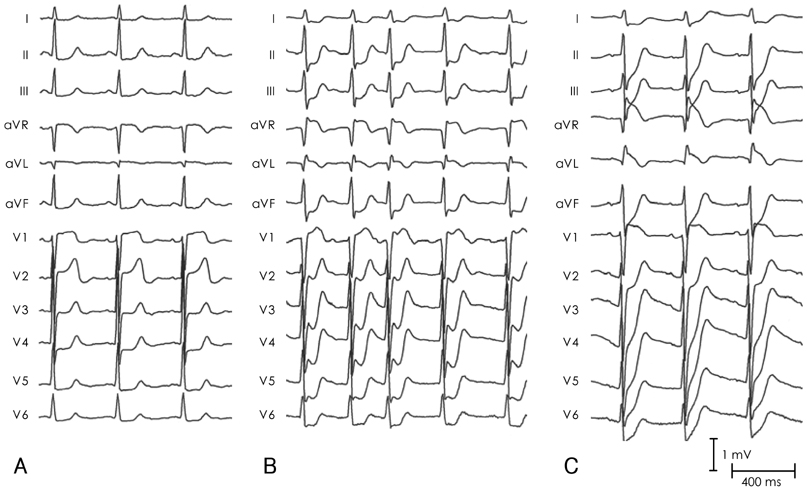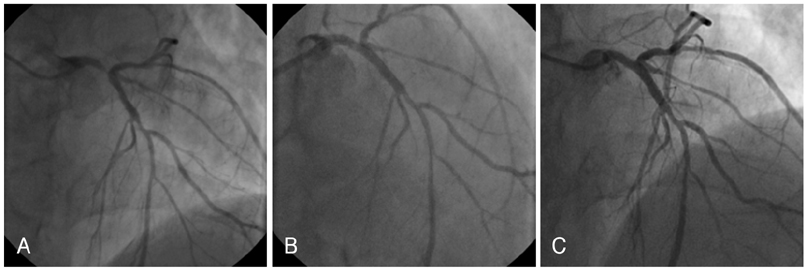Korean Circ J.
2008 Feb;38(2):119-121. 10.4070/kcj.2008.38.2.119.
Severe Stenosis of the Left Main Coronary Artery Detected on Electrophysiologic Study
- Affiliations
-
- 1Department of Internal Medicine, Pusan National University School of Medicine, Busan, Korea. mdjunkim@yahoo.co.kr
- KMID: 2225850
- DOI: http://doi.org/10.4070/kcj.2008.38.2.119
Abstract
- A cardiac electrophysiologic study (EPS) is a safe procedure with a low complication rate. We report here a case of severe stenosis of the left main coronary artery (LMCA) that was incidentally detected during an EPS; this was successfully managed by stenting the LMCA. The patient was a 75-year-old man with recurrent chest fluttering and no previous angina underwent EPS and he developed acute ischemic chest pain due to induced atrial fibrillation. The coronary angiography showed a critical stenosis in the distal LMCA. The patient underwent percutaneous coronary intervention with a sirolimus-eluting stent in the LMCA. The patient has remained asymptomatic during a 1-year follow-up period. To prevent potentially catastrophic complications, performing a stress myocardial imaging test should be strongly considered before conducting EPS in elderly patients.
MeSH Terms
Figure
Reference
-
1. Josephson ME. Electrophysiologic Investigation: Technical Aspects. Clinical Cardiac Electrophysiology Technique and Interpretation. 2002. 3rd. Philadelphia, Pennsylvania: Lippincott Williams & Wilkins;1–18.2. Dimarco JP, Garan H, Ruskin JN. Complications in patients undergoing cardiac electrophysiologic procedures. Ann Intern Med. 1982. 97:490–493.3. Chen SA, Chiang CE, Tai CT, et al. Complications of diagnostic electrophysiologic studies and radiofrequency catheter ablation in patients with tachyarrhythmias: an eight-year survey of 3,966 consecutive procedures in a tertiary referral center. Am J Cardiol. 1996. 77:41–46.4. Gaitonde RS, Sharma N, Ali-Hasan S, Miller JM, Jayachandran JV, Kalaria VG. Prediction of significant left main coronary artery stenosis by the 12-lead electrocardiogram in patients with rest angina pectoris and withholding of clopidogrel therapy. Am J Cardiol. 2003. 92:846–848.5. Barrabes JA, Figueras J, Moure C, Cortadellas J, Soler-Soler J. Prognostic value of lead aVR in patients with a first non-ST-segment elevation acute myocardial infarction. Circulation. 2003. 108:814–819.6. Yamaji H, Iwasaki K, Kusachi S, et al. Prediction of acute left main coronary artery obstruction by 12-lead electrocardiography: ST segment elevation in lead aVR with less ST segment elevation in lead V1. J Am Coll Cardiol. 2001. 38:1348–1354.7. Hirano T, Tsuchiya K, Nishigaki K, et al. Clinical features of emergency electrocardiography in patients with myocardial infarction caused by left main trunk obstruction. Circ J. 2006. 70:525–529.8. Park SJ, Kim YH, Lee BK, et al. Sirolimus-eluting stent implantation for unprotected left main coronary artery stenosis: comparison with bare metal stent implantation. J Am Coll Cardiol. 2005. 45:351–356.9. Park SJ, Park SW, Hong MK, et al. Long-term (three-year) outcomes after stenting of uprotected left main stenosis in patients with normal left ventricular function. Am J Cardiol. 2003. 91:12–16.10. Eagle KA, Guyton RA, Davidoff R, et al. ACC/AHA 2004 guideline update for coronary artery bypass graft surgery: a report of the American College of Cardiology/American Heart Association Task Force on Practice Guidelines (Committee to Update the 1999 Guidelines for Coronary Artery Bypass Graft Surgery). Circulation. 2004. 110:e340–e437.11. Lee SW, Hong MK, Kim YH, et al. Bail-out stenting for left main coronary artery dissection during catheter-based procedure: acute and long-term results. Clin Cardiol. 2004. 27:393–395.12. Park JH, Cho YH, Lee SW, et al. Long-term clinical follow-up in patients with left main coronary disease according to treatment strategies. Korean Circ J. 2003. 33:568–573.13. Park SJ, Park SW, Hong MK, et al. Stenting of unprotected left main coronary artery stenosis without anticoagulation: immediate and late outcomes. Korean Circ J. 1997. 27:947–957.14. Schwartz JB, Zipes DP. Zipes DP, editor. Cardiovascular disease in the elderly. Braunwald's Heart Disease: A Textbook Of Cardiovascular Medicine. 2005. 7th. Philadelphia, Pennsylvania: Elsevier Saunders;1925–1949.15. Coleman KA, Steingart RM, Pollack S, Cohen TJ. Utility of stress myocardial perfusion imaging performed before electrophysiologic testing. J Nucl Cardiol. 2003. 10:676–683.
- Full Text Links
- Actions
-
Cited
- CITED
-
- Close
- Share
- Similar articles
-
- Isolated Ostial left Main Stenosis Diagnosed by Transesophageal Doppler Echocardiography
- Percutaneous transluminal coronary angioplasty for ostial stenosis of the left coronary artery
- Isolated Coronary Ostial Stenosis Confirmed by Transesophageal Echocardiogram: A Case Report
- The Clinical Experiences of Patch Angioplasty in Isolated Critical Left Main Coronary Artery Stenosis
- A Case of Left Coronary Osteal Stenosis Combined with Moyamoya Disease



